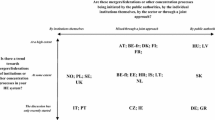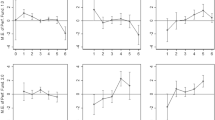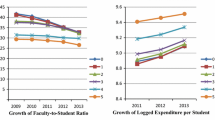Abstract
As interest increases in the educational quality of higher education institutions (HEIs), less is known about how the mergers and acquisitions (M&As) of these HEIs affect educational quality. In this study, we investigate the association of M&As on the educational quality of HEIs and the role of institutional incentives in this relation. We argue that M&As in HEIs can positively affect the educational quality of these institutions, although this relationship is substantially sensitive and moderated by institutional incentives. Ultimately, M&As can negatively influence educational quality if the incentives do not encourage HEIs to improve and maintain high standards in educational quality continuously. We empirically examine our theoretical framework using a longitudinal dataset on a fixed-effects model from 2007 to 2015 with M&As of Brazilian HEIs, and the results consistently support our arguments.







Similar content being viewed by others
References
Aarrevaara, T., Dobson, I., & Elander, C. (2009). Brave new world: Higher education reform in Finland. Higher Education Management and Policy, 21(2), 1–18.
Academic Ranking of World Universities. (2013). Academic ranking of world universities. Center for World-Class Universities of Shanghai Jiao Tong University.
Aghaz, A., Hashemi, A., & Sharifi Atashgah, M. S. (2015). Factors contributing to university image: The postgraduate students’ points of view. Journal of Marketing for Higher Education, 25(1), 104–126.
Belanger, C., Mount, J., & Wilson, M. (2002). Institutional image and retention. Tertiary Education & Management, 8(3), 217–230.
Boling, J. R., Mayo, D. T., & Helms, M. M. (2017). Complementarity merger as a driver of change and growth in higher education. Journal of Organizational Change Management, 30(1), 27–42.
Brazil (2004). Presidência da República. Lei 10.861 de 14 de abril de 2004. http://abmes.org.br/legislacoes/detalhe/560/lei-n-10.861. Accessed 21 May 2021
Brazil (2010). Presidência da República. Lei n. 12.202 de 14 de janeiro de 2010. http://www2.camara.leg.br/legin/fed/lei/2010/lei-12202-14-janeiro-2010-600572-norma-pl.html. Accessed 21 May 2021
Brazil (2019). Metodologia de cálculo do IGC. https://download.inep.gov.br/educacao_superior/enade/notas_tecnicas/2019/NOTA_TECNICA_N_59-2020_CGCQES-DAES_Metodologia_de_calculo_do_IGC_2019.pdf . Accessed 21 May 2021
Cai, Y., Pinheiro, R., Geschwind, L., & Aarrevaara, T. (2016). Towards a novel conceptual framework for understanding mergers in higher education. European Journal of Higher Education, 6(1), 7–24.
Cai, Y., & Yang, X. (2016). Mergers in Chinese higher education: Lessons for studies in a global context. European Journal of Higher Education, 6(1), 71–85.
Carvalho, C. H. A. D. (2013). A mercantilização da educação superior brasileira e as estratégias de mercado das instituições lucrativas. Revista Brasileira De Educação, 18(54), 761–776.
Castelló-Climent, A., & Hidalgo-Cabrillana, A. (2012). The role of educational quality and quantity in the process of economic development. Economics of Education Review, 31(4), 391–409.
Chaves, V. L. J. (2010). Expansão Da privatização/mercantilização do ensino superior brasileiro: A formação dos oligopólios. Educação & Sociedade, 31(111), 481–500.
Chen, J., & Hossler, D. (2017). The effects of financial aid on college success of two-year beginning nontraditional students. Research in Higher Education, 58(1), 40–76.
Collins, J. D., Holcomb, T. R., Certo, S. T., Hitt, M. A., & Lester, R. H. (2009). Learning by doing: Cross-border mergers and acquisitions. Journal of Business Research, 62(12), 1329–1334.
Croucher, G., & Woelert, P. (2016). Institutional isomorphism and the creation of the unified national system of higher education in Australia: An empirical analysis. Higher Education, 71(4), 439–453.
Damşa, C., de Lange, T., Elken, M., Esterhazy, R., Fossland, T., Frølich, N., ... & Aamodt, P. O. (2015). Quality in Norwegian Higher Education: A review of research on aspects affecting student learning. (NIFU 2015/24). Nordic Institute for Studies in Innovation and Education.
DiMaggio, P. J., & Powell, W. W. (1983). The iron cage revisited: Institutional isomorphism and collective rationality in organizational fields. American Sociological Review, 48(2), 147–160.
Docampo, D., Egret, D., & Cram, L. (2015). The effect of university mergers on the Shanghai ranking. Scientometrics, 104(1), 175–191.
Egeberg, M., Gornitzka, Å., & Trondal, J. (2015). An organizational approach to governance. Handbook on theories of governance. Edward Elgar.
Erosa, A., Koreshokova, T., & Restuccia, D. (2010). On the aggregate and distributional implications of TFP differences across countries. Review of Economic Studies, 77(4), 1421–1449.
Fan, Y. (2013). Ownership consolidation and product characteristics: A study of the US daily newspaper market. American Economic Review, 103(5), 1598–1628.
Frølich, N., & Stensaker, B. (2021). Mergers and missions: Investigating consequences for system diversity. Higher Education, 82, 411–434.
Frølich, N., Trondal, J., Caspersen, J., & Reymert, I. (2016). Managing mergers—governancing institutional integration. Tertiary Education and Management, 22(3), 231–248.
Gambirage, C., Xavier, W. G., da Silva, J. C., Greene, F., & Gandonou, M. (2017). Economic performance of private higher education institutions in distance education through mergers and acquisitions. Revista Eletrônica De Estratégia E Negócios, 10(1), 252–284.
Georghiou, L., & Harper, J. C. (2015). Mergers and alliances in context. In: Curaj, A., Georghiou, L., Harper J. C., & Egron-Polak, E. (Eds.), Mergers and alliances in higher education: International practice and emerging opportunities. London, Springer Open. https://doi.org/10.1007/978-3-319-13135-1
Gomes, A. V. A. (Org.). (2017). Plano Nacional de Educação: olhares sobre o andamento das metas. http://www.observatoriodopne.org.br/uploads/reference/file/678/documento-referencia.pdf. Accessed 21 May 2021
Hair, J. F., Black, W. C., Babin, B. J., Anderson, R. E., & Tatham, R. L. (2009). Análise multivariada de dados. Porto Alegre, Bookman.
Hair, J. F., Black, W. C., Babin, B. J., & Anderson, R. E. (2014). Multivariate data analysis: Pearson new international edition. Pearson Education Limited.
Haleblian, J., & Finkelstein, S. (1999). The influence of organizational acquisition experience on acquisition performance: A behavioral learning perspective. Administrative Science Quarterly, 44(1), 29–56.
Han, J., Kairies-Schwarz, N., & Vomhof, M. (2017). Quality competition and hospital mergers—An experiment. Health Economics, 26, 36–51.
Harman, G., & Harman, K. (2003). Institutional mergers in higher education: Lessons from international experience. Tertiary Education and Management, 9(1), 29–44.
Harman, G., & Harman, K. (2008). Strategic mergers of strong institutions to enhance competitive advantage. Higher Education Policy, 21(1), 99–121.
Hazelkorn, E. (2007). The impact of league tables and ranking systems on higher education decision making. Higher Education Management and Policy, 19(2), 1–24.
Hemsley-Brown, J., Melewar, T. C., Nguyen, B., & Wilson, E. J. (2016). Exploring brand identity, meaning, image, and reputation (BIMIR) in higher education. Journal of Business Research, 69(8), 3019–3022.
Hicks, D. (2012). Performance-based university research funding systems. Research Policy, 41(2), 251–261.
Huisman, J. (2008). World-class universities. Higher Education Policy, 21(1), 1–4.
INEP (2017). Exame Nacional de Desempenho de Estudantes (Enade). http://portal.inep.gov.br/web/guest/enade. Accessed 21 May 2021
Johnes, J. (2014). Efficiency and mergers in English Higher Education 1996/97 to 2008/9: Parametric and non-parametric estimation of the multi‐input multi‐output distance function. The Manchester School, 82(4), 465–487.
Johnes, J., & Li, Y. U. (2008). Measuring the research performance of Chinese higher education institutions using data envelopment analysis. China Economic Review, 19(4), 679–696.
Kang, Y., & Liu, R. (2021). Does the merger of universities promote their scientific research performance? Evidence from China. Research Policy, 50(1)
Krücken, G., & Meier, F. (2006). Turning the university into an organizational actor. Globalization and Organization: World Society and Organizational Change, 18(5), 241–257.
Kyvik, S., & Stensaker, B. (2013). Factors affecting the decision to merge: The case of strategic mergers in Norwegian higher education. Tertiary Education and Management, 19(4), 323–337.
Lehto, E., & Böckerman, P. (2008). Analysing the employment effects of mergers and acquisitions. Journal of Economic Behavior and Organization, 68(1), 112–124.
Mahoney, J., & Thelen, K. (Eds.). (2009). Explaining institutional change: Ambiguity, agency, and power. Cambridge University Press.
Mao, Y. Q., Du, Y., & Liu, J. J. (2009). The effects of university mergers in China since 1990s: From the perspective of knowledge production. International Journal of Educational Management, 23(1), 19–33.
March, J. G., & Olsen, J. P. (2006). Elaborating the new institutionalism. In R. A. W. Rhodes, S. Binder, & B. Rockman (Eds.), The Oxford handbook of political institutions (pp. 3–20). Oxford University Press.
McCowan, T. (2007). Expansion without equity: An analysis of current policy on access to higher education in Brazil. Higher Education, 53(5), 579–598.
Mello, J. M., & Duarte, I. F. (2020). The Effect of the availability of Student Credit on Tuition: Testing the Bennett hypothesis using evidence from a large-Scale Student Loan Program in Brazil. Economia, 20(2), 179–222.
Moeller, M., Harvey, M., Griffith, D., & Richey, G. (2013). The impact of country-of-origin on the acceptance of foreign subsidiaries in host countries: An examination of the ‘liability-of-foreignness.’ International Business Review, 22(1), 89–99.
Mok, K. H. (2005). Fostering entrepreneurship: Changing role of government and higher education governance in Hong Kong. Research Policy, 34(4), 537–554.
North, D. C. (1991). Institutions. Journal of Economic Perspectives, 5(1), 97–112.
Pereira, C. A., Araujo, J. F. F. E., & de Machado-Taylor, L. (2018). The Brazilian higher education evaluation model: SINAES Sui Generis? International Journal of Educational Development, 61, 5–15.
Pereira, T. L., & Brito, S. H. A. (2018). A expansão da educação superior privada no Brasil Por Meio do FIES. EccoS–Revista Científica, 47, 337–354.
Petersen, M. A. (2009). Estimating standard errors in finance panel data sets: Comparing approaches. The Review of Financial Studies, 22(1), 435–480.
Pinheiro, R., Geschwind, L., & Aarrevaara, T. (2016). Mergers in higher education. European Journal of Higher Education, 6(1), 2–6.
Polidori, M. M. (2009). Políticas De avaliação da educação superior brasileira: Provão, SINAES, IDD, CPC, IGC E outros índices. Avaliação: Revista Da Avaliação Da Educação Superior (Campinas), 14(2), 439–452.
Polidori, M. M., Marinho-Araujo, C. M., & Barreyro, G. B. (2006). SINAES: Perspectivas e desafios na avaliação da educação superior brasileira. Ensaio: avaliação e políticas públicas em educação, 14(53), 425–436.
Puusa, A., & Kekäle, J. (2015). Feelings over facts–a university merger brings organizational identity to the forefront. Journal of Higher Education Policy and Management, 37(4), 432–446.
Queiroz, V. D. (2015). Fundo De Financiamento Estudantil (FIES): uma nova versão do CREDUC. Universidade E Sociedade, 55, 44–57.
Ramirez, F. (2010). Accounting for excellence: Transforming universities into organizational actors. In V. Rust, L. Portnoi, & S. Bagely (Eds.), Higher education, policy, and the global competition phenomenon. Palgrave Macmillan.
Ripoll-Soler, C., & de-Miguel-Molina, M. (2014). Are mergers a win-win strategic model? A content analysis of inter-institutional collaboration between higher education institutions. Tertiary Education and Management, 20(1), 44–56.
Ripoll-Soler, C., & de-Miguel-Molina, M. (2019). Higher education mergers in Europe: A comparative study of the post-merger phase. Tertiary Education and Management, 25(3), 255–271.
Romanenko, K., & Froumin, I. (2020). University mergers in Russia from the students’ perspective: Uncertainty and loss of identity. Tertiary Education and Management, 26(2), 233–245.
Saccaro, A., & França, M. T. A. (2020). Stop-out and drop-out: The behavior of the first year withdrawal of students of the Brazilian higher education receiving FIES funding. International Journal of Educational Development, 77,
Salmi, J., & Saroyan, A. (2007). League tables as policy instruments: Uses and misuses. Higher Education Management and Policy, 19(2), 1–38.
Salto, D. J. (2018). To profit or not to profit: The private higher education sector in Brazil. Higher Education, 75(5), 809–825.
Sarfati, G., & Shwartzbaum, A. (2013). Sinergias Nas fusões e aquisições do setor de educação superior no Brasil. Revista Pensamento Contemporâneo em Administração, 7(4), 1–23.
Sécca, R. X., & Leal, R. M. (2009). Análise do setor de ensino superior privado no Brasil. BNDES Setorial, 30, 103–156.
Skodvin, O. J. (1999). Mergers in higher education-success or failure? Tertiary Education and Management, 5(1), 65–80.
Stensaker, B., & Harvey, L. (2006). Old wine in new bottles? A comparison of Public and Private Accreditation schemes in Higher Education. Higher Education Policy, 19(1), 65–85.
Tavares, R. S., & Meza, L. A. (2020). Performance evaluation of undergraduate courses at a Brazilian Federal University. Ensaio: Avaliação E Políticas Públicas em Educação, 29(110), 206–233.
Thomas, L., & Hovdhaugen, E. (2014). Complexities and challenges of researching student completion and non-completion of HE programmes in Europe: A comparative analysis between England and Norway. European Journal of Education, 49(4), 457–470.
Tight, M. (2013). Institutional churn: Institutional change in United Kingdom higher education. Journal of Higher Education Policy and Management, 35(1), 11–20.
Tolbert, P. S., & Zucker, L. G. (1983). Institutional sources of change in the formal structure of organizations: The diffusion of civil service reform, 1880–1935. Administrative Science Quarterly, 28, 22–39.
Ursin, J., Aittola, H., Henderson, C., & Valimaa, J. (2010). Is education getting lost in university mergers? Tertiary Education and Management, 16(4), 327–340.
Vidaver-Cohen, D. (2007). Reputation beyond the rankings: A conceptual framework for business school research. Corporate Reputation Review, 10(4), 278–304.
Wiers-Jenssen, J., Stensaker, B., & Grøgaard, J. B. (2002). Student satisfaction: Towards an empirical deconstruction of the concept. Quality in Higher Education, 8(2), 183–195.
Williams, R. L., Jr., & Omar, M. (2014). Applying brand management to higher education through the use of the brand flux Model™–the case of Arcadia University. Journal of Marketing for Higher Education, 24(2), 222–242.
Worthington, A. C., & Higgs, H. (2011). Economies of scale and scope in Australian higher education. Higher Education, 61(4), 387–414.
Yorke, M. (1998). Undergraduate non-completion in England: Some implications for the higher education system and its institutions. Tertiary Education and Management, 4(1), 59–70.
Zhang, J., Deephouse, D. L., van Gorp, D., & Ebbers, H. (2020). Individuals’ perceptions of the legitimacy of emerging market multinationals: Ethical foundations and construct validation. Journal of Business Ethics, 176, 801–825.
Acknowledgements
The authors thank the Editor and anonymous reviewers for their many constructive comments and suggestions during the revision process, which greatly contributed to improving the paper. The usual disclaimer applies, and all errors are ours.
Author information
Authors and Affiliations
Corresponding author
Ethics declarations
Conflict of interest
We have no conflicts of interest to disclose.
Additional information
Publisher’s Note
Springer Nature remains neutral with regard to jurisdictional claims in published maps and institutional affiliations.
Rights and permissions
Springer Nature or its licensor (e.g. a society or other partner) holds exclusive rights to this article under a publishing agreement with the author(s) or other rightsholder(s); author self-archiving of the accepted manuscript version of this article is solely governed by the terms of such publishing agreement and applicable law.
About this article
Cite this article
da Silva, J.C., dos Reis, E.A., Marcon, R. et al. Mergers and acquisitions and educational quality of higher education institutions. Tert Educ Manag 30, 17–44 (2024). https://doi.org/10.1007/s11233-023-09132-z
Received:
Accepted:
Published:
Issue Date:
DOI: https://doi.org/10.1007/s11233-023-09132-z




